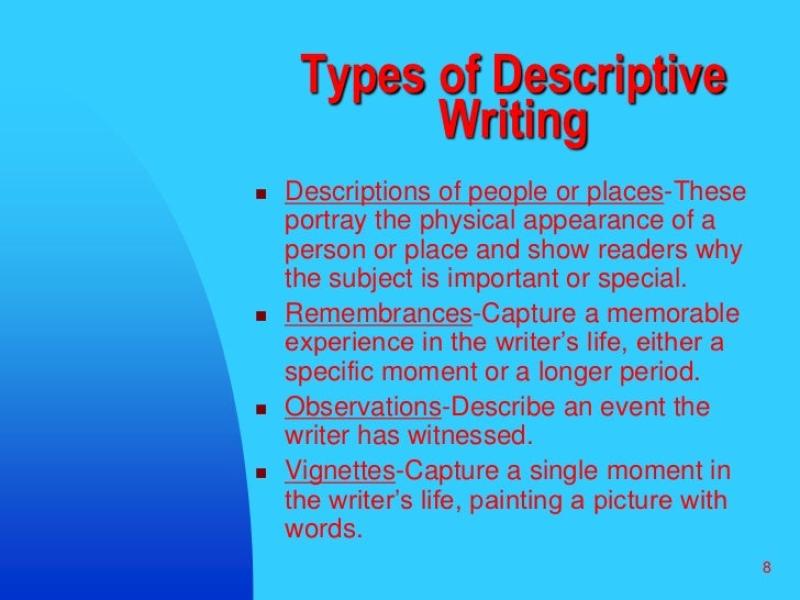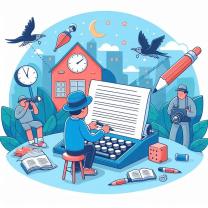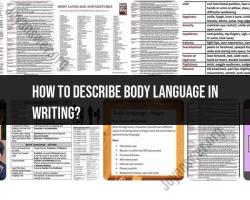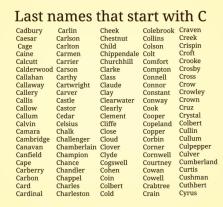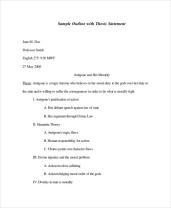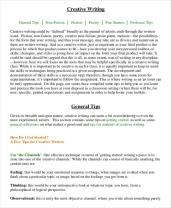What are the types of descriptive writing?
Descriptive writing is a form of writing that aims to provide a detailed and vivid portrayal of a person, place, thing, or experience. It employs sensory details, figurative language, and other literary devices to create a clear and engaging picture for the reader. Here are some common types of descriptive writing:
Descriptive Essays:
- Description: Essays that paint a detailed picture of a person, place, or event using sensory details, vivid language, and a clear structure.
- Example: Describing a memorable vacation spot or a significant personal experience.
Travel Writing:
- Description: Writing that vividly portrays the details of a location, conveying the atmosphere, culture, and unique features of a place.
- Example: Describing the sights, sounds, and experiences of a trip to a foreign country.
Character Sketches:
- Description: Focused on providing a detailed and in-depth portrayal of a character's appearance, personality, and traits.
- Example: Describing the main character in a novel or a character from a short story.
Nature Writing:
- Description: Describing the natural world, landscapes, and environmental features with a focus on sensory imagery and emotional impact.
- Example: Describing a serene forest, a majestic mountain range, or a vibrant sunset.
Object Description:
- Description: Detailing the physical attributes, characteristics, and significance of an object.
- Example: Describing a cherished family heirloom, a work of art, or a unique piece of furniture.
Observational Writing:
- Description: Capturing details from direct observations, often in real-time, to convey a sense of immediacy and authenticity.
- Example: Describing the sights and sounds of a bustling city street or the behavior of people in a park.
Personal Reflections:
- Description: Reflecting on personal experiences, emotions, and memories with a focus on conveying the subjective aspects of the writer's feelings.
- Example: Describing the emotions and details associated with a significant life event.
Food Writing:
- Description: Using detailed sensory descriptions to convey the appearance, taste, and aroma of food.
- Example: Describing a delicious meal, a culinary experience, or the atmosphere of a restaurant.
Historical Descriptions:
- Description: Portraying historical events, settings, or characters with attention to detail and accuracy.
- Example: Describing a significant historical event, a period in time, or the details of a historical figure's life.
Event Descriptions:
- Description: Detailing the features and atmosphere of an event, whether it's a celebration, concert, or cultural gathering.
- Example: Describing a music festival, a wedding ceremony, or a sports competition.
In all these types of descriptive writing, the goal is to engage the reader's senses and imagination, creating a rich and immersive experience through words. Effective descriptive writing transports the reader to the described scene, allowing them to visualize and connect with the subject on a deeper level.
What are the various forms of descriptive writing?
There are many different forms of descriptive writing, including:
- Sensory description: Sensory description uses language to evoke the reader's senses, such as sight, smell, taste, touch, and sound.
- Objective description: Objective description describes things as they are, without the writer's personal opinions or interpretations.
- Subjective description: Subjective description describes things from the writer's personal perspective, including their opinions and interpretations.
- Figurative language: Figurative language uses words and phrases in a non-literal way to create a more vivid and evocative image in the reader's mind. Some common types of figurative language include simile, metaphor, personification, and hyperbole.
- Imagery: Imagery is the use of language to create a picture in the reader's mind.
How does descriptive writing differ across genres and styles?
Descriptive writing can be used in all genres of writing, including fiction, nonfiction, poetry, and drama. However, the way that descriptive writing is used can vary depending on the genre and style of writing.
For example, in fiction, descriptive writing is often used to create a vivid and believable world for the reader. In nonfiction, descriptive writing is often used to explain complex concepts or to transport the reader to a different place or time. In poetry, descriptive writing is often used to create a mood or atmosphere. And in drama, descriptive writing is often used to create a setting or to reveal character.
3. Examples of effective descriptive writing techniques
Here are some examples of effective descriptive writing techniques:
- Use specific and concrete language: Avoid using vague and general language. Instead, use specific and concrete language that will help the reader to visualize what you are describing. For example, instead of saying "The house was big," you could say "The house was a three-story Victorian mansion with a wraparound porch and a turret."
- Use sensory details: Use sensory details to help the reader experience what you are describing. For example, instead of saying "The food was good," you could say "The food was delicious. The chicken was juicy and flavorful, and the mashed potatoes were creamy and buttery."
- Use figurative language: Use figurative language to create a more vivid and evocative image in the reader's mind. For example, instead of saying "The sun was setting," you could say "The sun was a fiery ball of orange and red that was sinking slowly below the horizon."
- Show, don't tell: Instead of telling the reader what something is like, show them. This means using descriptive language to create a picture in the reader's mind. For example, instead of saying "The man was angry," you could say "The man's face was red and his jaw was clenched. His fists were clenched at his sides."
Here is an example of effective descriptive writing from the novel The Lord of the Rings by J.R.R. Tolkien:
"The land was green and full of wide meadows with an occasional tree or group of trees. In the distance were hills, and beyond them mountains, the tallest with snow on their peaks. The air was clear and cool, and the sun shone brightly."
Tolkien uses specific and concrete language to create a vivid and believable world for the reader. He also uses sensory details, such as the "green meadows," the "occasional tree," and the "clear and cool air," to help the reader to experience the setting.
Descriptive writing can be a powerful tool for writers of all genres. By using effective descriptive writing techniques, writers can create a vivid and immersive world for their readers and bring their stories to life.
